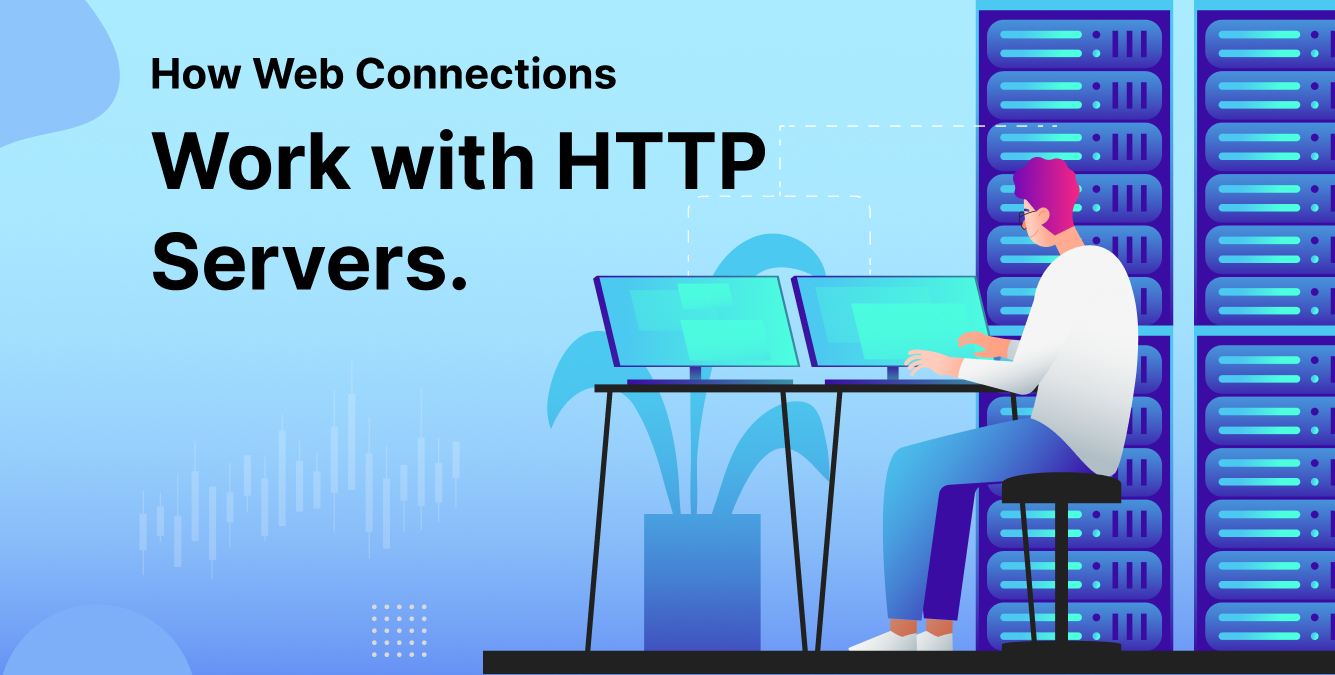How Web Connections Work with HTTP Servers – Explained



Introduction
Every time you click on a link, submit a form, or open a webpage, a lot happens behind the scenes—usually in less than a second. At the center of this process are HTTP servers, which quietly help deliver content to your screen.
Knowing how web connections work with HTTP servers isn’t just for developers or tech experts. In today’s online world, anyone who manages a website—especially people working in a digital marketing agency—can benefit from understanding the basics. It helps improve SEO, page speed, and user experience.
In this article, we’ll explain how web servers work, how they connect with browsers using HTTP, and why this matters to businesses and marketers. We’ll also look at useful tips to make your website faster and more reliable, all while following Google’s E-E-A-T guidelines: experience, expertise, authoritativeness, and trust.
Web Server- Definition and Examples
A web server is both a physical machine and a software application. At its most basic level, it stores, processes, and delivers web pages to clients, typically web browsers. When a user types a URL into their browser, the browser acts as a client requesting information. The server receives the request, finds the appropriate file or data, and sends it back.
Web servers play a central role in the client-server model of the internet. Popular examples include:
- Apache HTTP Server – Open-source, widely used
- Nginx – Known for high performance and concurrency
- LiteSpeed – Focused on speed and resource efficiency
These servers handle different types of content—static files (HTML, CSS, images) and dynamic content generated via languages like PHP or JavaScript.
From a practical perspective, when digital marketing professionals ask, “How does a server work?”—they’re often really asking how well their websites deliver content. That comes down to how the server receives and responds to HTTP requests.
What Is HTTP and Why Is It Important?
HTTP stands for HyperText Transfer Protocol, the foundation of any data exchange on the Web. It defines how messages are formatted and transmitted, and how web servers and browsers should respond.
When you enter a URL in a browser:
- The browser sends an HTTP request to the server.
- The server processes that request.
- The server sends back an HTTP response—usually with a status code and content.
HTTP Status Codes
Understanding status codes is essential for diagnosing website server issues:
- 200 OK – The request was successful.
- 301 Moved Permanently – Redirects the client to another URL.
- 404 Not Found – The requested resource doesn’t exist.
- 500 Internal Server Error – Generic server error.
There’s also HTTPS, the secure version of HTTP. It uses SSL/TLS to encrypt the connection, protecting data like passwords or credit card details.
How Web Connections Work: Step-by-Step
A fast and reliable HTTP connection is essential for delivering a smooth browsing experience and ensuring that users can access your website without delays. Let’s break down what happens from the moment you visit a website:
Step 1: DNS Resolution
Your browser contacts a Domain Name System (DNS) server to convert the domain (e.g., www.example.com) into an IP address.
Step 2: TCP Handshake
Once the IP is known, a Transmission Control Protocol (TCP) connection is established between the client and server.
Step 3: HTTP Request
The browser sends an HTTP request to the server. This includes headers, cookies, and any form data.
Step 4: Server Processing
The server receives the request, interprets it (possibly querying a database), and prepares a response.
Step 5: HTTP Response
The server sends back a response containing:
- Status code (200, 404, etc.)
- Headers (metadata like content type, length)
- Body (HTML, JSON, etc.)
Step 6: Browser Rendering
The browser renders the page using the received HTML, CSS, and JavaScript.
This entire process often takes less than a second, especially if optimized. For businesses, especially a digital marketing agency, every millisecond counts. A fast server response can mean higher conversions and better SEO performance.
Behind the Curtain: How Does a Server Work?
Behind every successful web interaction is a well-configured server. But what exactly happens behind the scenes?
Hardware vs Software
- Hardware servers are physical machines located in data centers.
- Virtual or cloud servers emulate physical hardware on cloud platforms like AWS or Google Cloud.
Server Roles
- Serving static content like images or CSS.
- Generating dynamic content like a product catalog.
- Handling API requests for mobile apps or third-party integrations.
Hosting Types
- Shared Hosting: Cost-effective but limited performance.
- VPS (Virtual Private Server): Greater control and isolation.
- Dedicated Hosting: Best for high-traffic websites.
- Cloud Hosting: Scalable and reliable.
Knowing how a web server works enables better decision-making when setting up a website or improving its infrastructure.
HTTP/1.1 vs HTTP/2 vs HTTP/3
Web protocols evolve to handle increasing demands. Here’s a quick comparison:
HTTP/1.1
- One request per connection.
- Slower for modern websites.
HTTP/2
- Multiplexing (multiple requests in parallel).
- Better compression and server push.
HTTP/3 (based on QUIC)
- Uses UDP instead of TCP.
- Faster connection setup and recovery.
- Especially beneficial for mobile browsing.
Using HTTP/2 or HTTP/3 can significantly improve site speed—a critical factor in Core Web Vitals and SEO.
Common Server-Side Technologies
Servers don’t work alone. They often run applications written in various languages:
- PHP – Common with WordPress and CMS-based websites.
- Node.js – Good for scalable, real-time apps.
- Python – Often used in data-driven websites.
- Java – Enterprise-grade applications.
There’s also a growing trend toward headless CMSs and serverless architectures, changing how traditional web servers are used.
Static sites (e.g., built with Hugo or Jekyll) are faster but less dynamic, while dynamic sites offer personalization at the cost of speed and complexity.
Why Your Digital Marketing Agency Should Understand HTTP Servers
Most marketing teams don’t need to become server administrators—but basic understanding is crucial. Here’s why:
- Search Engine Optimization (SEO): Google factors in page speed and performance.
- Conversion Rate Optimization: A delay of even one second can reduce conversions by up to 20%.
- Content Delivery: Optimizing how and where your site is hosted can affect global accessibility.
Collaboration between marketing and technical teams leads to better outcomes—particularly when optimizing for Core Web Vitals.
How Poor Server Configurations Hurt Your Business
Even the best-designed website can underperform due to server issues. Common pitfalls include:
- Slow Time to First Byte (TTFB): Indicates delays in server response.
- Server Downtime: Lost revenue and reputation.
- Security Flaws: Outdated internet servers or unpatched software can lead to breaches.
- Unoptimized Headers: Prevent caching and slow down repeat visits.
Tools like GTmetrix or Google PageSpeed Insights can diagnose these issues, but resolving them often requires expert input.
Best Practices for Optimizing Server Connections
Some simple server-side tweaks can make a big difference:
- Enable caching: Store frequently accessed data closer to users.
- Use a CDN (Content Delivery Network): Distribute content via servers across the globe.
- Implement gzip or Brotli compression: Reduces the size of files sent to browsers.
- Use HTTP keep-alive: Reuses existing connections to reduce latency.
- Optimize headers: Set appropriate cache and security headers.
Regular audits, especially by experienced web consultants, ensure that the server of your website performs at its best.
Future of Web Connections and HTTP
The web is constantly evolving, and server technology must keep up. Future trends include:
- QUIC and HTTP/3 adoption across more ISPs and browsers.
- Edge computing, bringing server logic closer to the user.
- AI-based traffic routing to predict and adjust for spikes.
- Web3 and decentralized hosting, potentially reshaping server infrastructure entirely.
Staying current with these trends can future-proof your business and improve competitive advantage.
Conclusion
From the first DNS lookup to the final byte delivered, every interaction between a browser and a web server involves a finely tuned process. Understanding how web connections and HTTP servers work isn’t just an academic exercise—it’s a practical necessity for anyone managing a website in 2025.
For digital marketing agencies, in particular, this knowledge bridges the gap between strategy and execution. A well-optimized server contributes to faster load times, better SEO, and improved user experience—all leading to tangible business outcomes.
Looking to improve your website’s performance? Hire Core Web Vitals Consultants to ensure your server setup supports your business goals from the ground up.
Frequently Asked Questions (FAQs)
HTTP is the basic protocol for data transfer on the web. HTTPS adds encryption via SSL/TLS, ensuring secure communication between server and browser. It’s essential for protecting user data and improving SEO rankings.
When a browser sends a request to a server, it includes a path (e.g., /about). The server uses this path to locate the corresponding file or route. If it’s a dynamic site, the server might generate the page using backend code.
Speed depends on many factors, including server configuration, hosting type, use of CDNs, image optimization, and the underlying web technology. A well-optimized server and site architecture make a big difference.
Absolutely. Understanding the basics helps marketers work better with developers, identify performance issues, and optimize for SEO and conversions. It also adds technical credibility when presenting to clients.
This is a generic error when something goes wrong on the server side—often due to misconfigurations, script errors, or overload. Reviewing server logs or working with hosting support is the best way to resolve it.